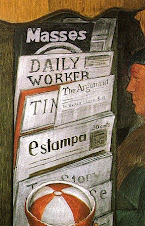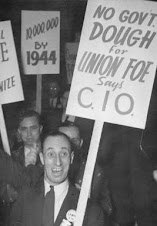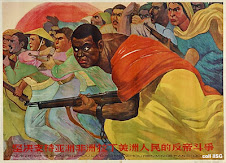By Caleb T. Maupin
Published Jan 31, 2008 8:23 PM
On Jan. 30, 1968, Vietnam was divided and in the midst of a war for liberation. The northern part of Vietnam was under the control of a socialist government of workers and peasants. The southern part of Vietnam remained under the control of a regime bought and sold to U.S. bankers and capitalists. Peasants in southern Vietnam remained landless and hungry, and slums and poverty filled Vietnam’s large urban centers. But all throughout South Vietnam, the spirit of resistance was flowing.
In North Vietnam, the soldiers wore armbands showing their solidarity with their southern country folk. The armbands read “Born in the North, Died in the South.”
The Buddhist holiday of Tet marks the Lunar New Year, and was traditionally celebrated in Vietnam in late January and early February. In years previous to 1968, the National Liberation Front of Vietnam had signed peace treaties with the United States to mark the holiday.
The NLF planned an attack on U.S. forces for the Tet holiday, so their people could celebrate the holiday before the vicious bombings that would come from the U.S. in retaliation. They knew the U.S. would respond with brutality.
Already the U.S. was viciously bombing Vietnam. By the war’s end, more bombs would fall on the Vietnamese people than had been dropped in all of the Second World War. When directly bombing North Vietnamese cities and villages failed to weaken the Vietnamese resistance, the U.S. began bombing dams, causing massive flooding and a famine in Vietnam’s agriculture-based countryside.
Some estimate that as many as 4 million Vietnamese people died as a result of the bombing campaigns, which Gen. Curtis Lemay proclaimed were done to “bomb them back into the stone age.” Later, in 1972, the U.S. would drop 800,000 tons of explosives on Southeast Asia in one year alone.
The Tet Offensive struck 36 of the 43 provincial capitals of Vietnam. In each city, the attacks were similar. The guerrilla soldiers of the NLF were able to sneak into villages under the cover of the Tet celebrations. In some cities they were even able to test explosive weapons under the cover of the holiday fireworks.
Once inside the cities, with supporters residing within them acting as guides, they would wage mortar attacks on key sites and do their best to get control.
The attack on Saigon
Saigon, now called Ho Chi Minh City, was the capital city of the puppet government of Vietnam. It was also a city in which many Vietnamese people lived in poverty and longed to resist. The city, which had not been rocked in nearly 20 years, was suddenly the site of a massive insurrection.
NLF guerillas infiltrated and assaulted the U.S. occupiers right within their own embassy, which had been built up with massive security following a bombing. The diplomats were forced to barricade themselves inside inner rooms as the fighting went on, in the equivalent of modern day Iraq’s “green zone.”
After the fighting had subsided, U.S. troops ordered the slaughter of all people within the embassy who were “not American.” This included many Vietnamese people who had been hired to work at the embassy and had had no part in the rebellion.
The National Radio Station, which the U.S. used to broadcast pro-imperialist propaganda throughout Vietnam, was also invaded. Guerrillas were able to liberate much of the station’s $1 million worth of equipment, and destroy what they couldn’t take with them.
During the Tet Offensive, a Saigon prison was busted into by the National Liberation Front. In South Vietnam 65,000 people were in prison, most of them political prisoners. These prisons were known for beatings and torture at the hand of the puppet forces of the South Vietnamese government. Five thousand prisoners were set free from the clutches of the U.S. backed regime and joined the insurrection.
A horrific scene unfolded in the streets of Saigon during the rebellion. A leader of the police forces of South Vietnam carried out an on-the-spot execution of an NLF supporter. Police officers walked the man over to Police Chief Ngoc Loan, who promptly put a gun to his head and pulled the trigger in front of the lenses of Western television reporters. Soon the picture of this killing was on the front pages of newspapers and headlined on the evening news in the Western world. This helped turn many against the war in Vietnam and strengthened the anti-war movement.
Paper tigers
“Imperialism and all reactionaries are paper tigers,” Mao Zedong wrote, and he was proved correct by the Tet Offensive and the eventual outcome of the Vietnam War. All of the countless thousands of U.S. CIA agents and spies in Vietnam could not predict the Tet Offensive. The Vietnamese were able to score massive blows against the U.S. occupiers. U.S. forces clearly had underestimated the strength of the Vietnamese people, who desperately wanted to be free from the clutches of U.S. imperialism and capitalism.
Eventually, the U.S. was forced to withdraw from Vietnam, as resistance flowed throughout the U.S. military itself and the streets of the U.S. were filled with militant youth. Fifty-eight thousand U.S. troops were sent to their death in Vietnam by the rulers of the U.S. Many more came home to spend the rest of their lives disabled or homeless.
It’s been 40 years since the Tet Offensive and since Vietnam has liberated itself from U.S. imperialism and established a socialist government that has redistributed land to the peasants, raised the life expectancy by 14.7 years and cut infant mortality in half.
All of this would not have been possible without the heroism of countless millions of Vietnamese people who fought and died for the liberation of their country—especially those who surged forth, 40 years ago, in the Tet Offensive.
--------------------------------------------------------------------------------
Articles copyright 1995-2007 Workers World. Verbatim copying and distribution of this entire article is permitted in any medium without royalty provided this notice is preserved.
Workers World, 55 W. 17 St., NY, NY 10011
Email: ww@workers.org
Subscribe wwnews-subscribe@workersworld.net
Support independent news http://www.workers.org/orders/donate.php
Subscribe to:
Post Comments (Atom)










































No comments:
Post a Comment